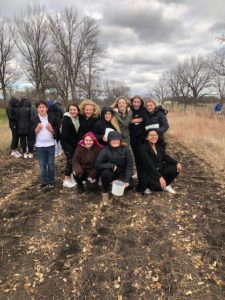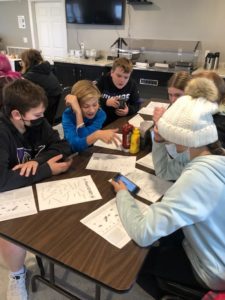By Mary Beth Botz
On November 17, 2021, the Sleepy Eye YES! Team met at the Sleepy Eye golf course to learn about the importance of the prairie ecosystem and to plant native forbs (flowers) as part of a continuing habitat restoration project. The afternoon consisted of both indoor and outdoor direct involvement activities.

Nate Fore, Pheasants Forever Farm Bill Biologist for Brown County, briefly explained his job as a farm bill biologist, stressed how November planting of prairie seed mimics nature’s own methods, and guided students in a plant identification activity. Next, several senior YES! Team members demonstrated to the younger members the native bee houses that they constructed several years ago. According to the DNR’s Minnesota Pollinators web page, “Wild bees provide vital pollination services and are an integral component of biodiversity.” To wrap up the indoor activities, YES! coaches Deb Reinarts and Mary Beth Botz involved students in the process of how to determine a particular mix of seeds for prairie biodiversity.
Moving outdoors, students formed a golf cart convoy and drove to the planting site in the rough area along the fairway leading to hole #3. Karl Weiss, golf course superintendent, prepared and tilled the 0.35 acre strips earlier in the month. Students hand scattered the seeds and then stepped them into the soil, mimicking the bison herds that, for thousands of years, trampled the seeds into the ground as they roamed the prairies.

This recent planting extends a prairie restoration project started in May and June of 2018, when the YES! Team designated three 0.33-acre plots in the rough areas between fairways to be sown with a seed mix certified to contain native Minnesota forbs and grasses. At the time, Team members developed a 5-year management plan to assure that the plots established well and would thrive. When reassessing the three areas in August 2021, the YES! Team coaches, Megan Benage, DNR Regional Ecologist, and Karl Weiss formulated plans to remediate one of the plots that is overrun with Canada thistles, expand another of the existing plots, and establish a new 1.33-acre plot. In all, 2.7 more acres were added to the original restoration area. Benage worked with Minnesota Native Landscapes, Inc of Otsego, MN, to prepare a seed mix which contains a mix of grasses and forbs appropriate for the ecology of the sites. Mr. Weiss seeded the larger areas not hand planted by the students. The ongoing management plan assures that the YES! Team will continue to monitor the sites, and the golf course superintendent supports the team’s efforts with the needed management tasks—planting, mowing, raking, burning, etc.
Partial funding for the prairie seed mixes was granted through Pheasants Forever and Quail Forever’s Pollinator Habitat Outreach Program, which is designed to provide financial assistance to engage youth, families and local communities in establishing pollinator habitat projects. The objectives of this program are to educate youth on the importance of pollinators and to establish quality pollinator habitats. Nate Fore was instrumental in initiating this new partnership between PF/QF and the YES! Team. In the future, he plans to provide additional education and habitat management guidance. National sponsors for the Pollinator Habitat Outreach Program include Bayer, Monarch Joint Venture, Cabela’s, Corteva Agriscience, and the U.S. Fish & Wildlife Service.